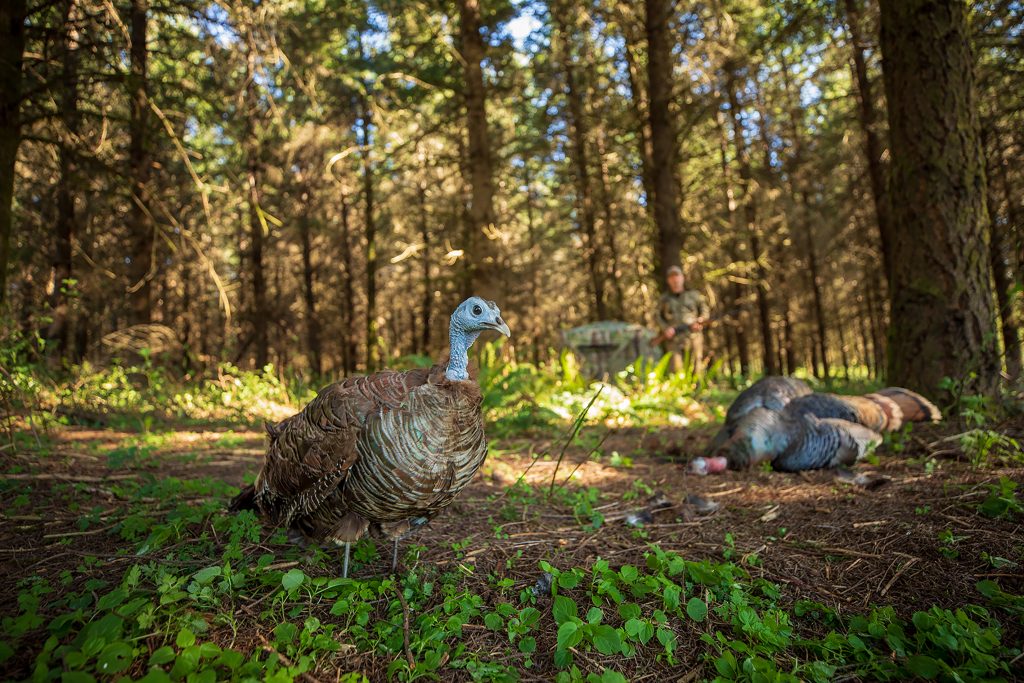Big Timber Toms All Season Long
Fields and openings can be fun, but hunting amid the trees pays big dividends.
Distant gobbles echoed through the valley below. The toms were farther away than anticipated. Confident in my scouting intel, I stayed put. Calling commenced as daylight crept down the towering Douglas fir trees under which I sat.
Situated in a ground blind at the intersection of three game trails atop a ridge, I heard the distant gobblers answer my sounds. Thirty minutes later, and without warning, a thundering gobble erupted. More gobbles ensued.
They came in silently, almost brushing against the blind as they passed. Cautiously, three gobblers strutted to the decoy. The shot was simple. It was opening day, and I’d filled the first of three tags in my home state of Oregon.
The next morning, I was on the opposite ridge, searching for the gobblers that had serenaded me the previous morning. I found them, and five came to my calls. They were less vocal than 24 hours earlier. They stuck to the timber, coming in on a string down a well-used elk trail. Then I had one tag left, which I saved for later in the season. During late May, a lone longbeard came gobbling into the decoy, again amid the forest, far from any meadows or farmland.
Why the Timber?

Early in my turkey hunting endeavors, I focused on meadows and fields. There were countless days of frustration where I failed to pull birds across or from openings. No matter what sounds I offered, what decoys I used, or the time of the season, I often left defeated.
Twenty-two years ago, I hunted northern Idaho with a buddy. We killed four toms, all in thick timber on public land. It was late in the season. My friend lived in the area and knew it well. He also knew that hunting pressure throughout the season put birds in the timber. What amazed me most about that hunt was the amount of thick cover the birds were willing to traverse to reach our calls.
After that experience, I paid closer attention to turkey behavior and movement to better understand what they do and why. It started with increased scouting, followed by running dozens of trail cameras year-round. Now I’m obsessed. What I’ve observed has even surprised me.
It’s noteworthy how much ground some turkeys cover under the forest canopy. Many times, I’ve seen — in person or on trail cameras — easy-to-identify birds in one spot only to see them three or more miles away a few days later. Trail cameras spread across several miles of timbered ridges and wooded draws have revealed turkeys feeding, drinking, taking dust baths, and roosting in timber all day throughout the year.
Of course, rain, high winds and wet snow often drive turkeys into the forest. In these conditions, birds often congregate beneath trees with thick boughs that protect them from the elements. Some of my best hunting days in the timber have come during cold, wet days when I used to stay home.

High predator numbers also force turkeys into the protection of the forest. In recent years, I’ve seen a direct correlation between bobcat and raptor predation in turkey movement. Gray foxes, raccoons, skunks and others prey on nests. Bobcats and raptors kill turkeys, and that moves birds to heavy cover.
“Coyotes and hot weather are when I switch the focus to hunting turkeys in the timber,” said noted Oregon guide Jody Smith (jodysmithguideservice.com). Smith hunts the brush-choked Coast Range, guiding more than 60 hunters a season for the past 25 years.
“When coyotes show up, our birds move into the timber,” he said. “They don’t go in very far because it’s so thick, but there’s no pulling them into the open when they’re on alert. That’s when we head for the trees, hunting inside forest fringes.”
Where Smith hunts, spring temperatures eclipse 80 later in the season.
“When it’s this hot, turkeys often hang out in the timber all day,” he said. “They find all the food, water and shade they need. We have to go in after those birds, too.”
Timber Moves
When conditions are wet and cold, a preening hen decoy is a great choice for hunting in timber. Spring scouting has opened my eyes to how long hens spend each day preening amid trees in wet conditions. Toms always seem to find them.
On windy days in the trees — especially where underbrush and ferns flourish — consider going without a decoy. Toms are already leery in such conditions, and with no decoy to see, an approaching gobbler will often keep on the move, searching for the source of the sounds.
When hunting where multiple trails converge, and scouting has revealed birds are using an area, hunt from a ground blind. This is especially helpful if you’re planning on sitting for an extended time, or if multiple birds might approach from any direction.
If you’re hunting big timber, especially at higher elevations, stay mobile. Depending on the weather conditions, bird numbers and the phase of the season, you might have to cover ground, as birds can be reluctant to come to you. Going with a light pack and only one decoy — or without a decoy — lets you get where you want to be more easily.
Being proficient with a range of calls greatly helps timber hunters. Box calls penetrate thick forests and buck the winds. High-pitched pot calls do the same and offer variety. A selection of diaphragm calls provides an array of sounds, and they’re nice to have when operating hand calls is risky.
One trend I’ve witnessed in multiple states is the later in the season, the more gobblers move into timbered habitats. Predators, hunting pressure and weather might drive them there, but typically it’s hens that keep them there. These aggressive gobblers can be fun to try to fool as the season winds down.
